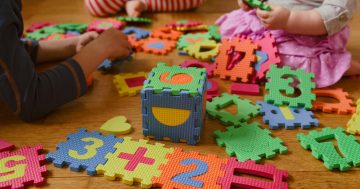
The Federal Parliament yesterday passed the so called ‘Jobs for Families Package’ – a $1.6 billion investment with a newchild care subsidy that will scrap the current Child Care Benefit and the Child Care Rebate payments.
This Package affects the around 28,230 children who attend child care here in the ACT, across some 379 approved child care services.
Despite being less than half of the investment promised by Government (and delayed by a year), it is the largest reform of child care subsidies since the Child Care Benefit was established.
Not surprisingly the new subsidy is called Child Care Subsidy, and it will have as significant effect on how children can access early learning in Canberra.
But if you thought it was going to be easy to work out if you are better off under the new system then you are very wrong. Despite rolling existing payments into one, the Federal Government has made the job of calculating your child care entitlements even more complex.
Check your subsidy rate
The subsidy rate is based on your income – a flat 85% subsidy for the lowest income families (families on $65,710 or less) tapering down to 50% subsidy for families on 170,710 family income per year.
The subsidy is then provided at a flat 50% for families up to $250,000 tapering down to 20% for families on $340,000. The highest income earners above $350,000 family income will receive 0% subsidy thanks to Derryn Hinch (which is hard to argue with but also doesn’t save that much money).
For some families this subsidy rate will be less than their current entitlements, particularly in Canberra where incomes tend to be higher – and almost everyone used to be eligible for the 50% Child Care Rebate. Other families will receive a slightly higher subsidy rate under the new system more depending on their circumstances, including the price of your current child care provider.
Check your activity
The number of hours of subsidy you are eligible for depends heavily on how much activity you do – the result of a new three tiered activity test. Generally the more hours of activity you do the more subsidised hours you are entitled to.
The first tier of the activity test requires that both parents must work or study for eight hours per fortnight in order to be eligible to receive subsidies. This may be problematic for those families where one parent is unable to work or do other eligible activity, particularly vulnerable families.
The good news is that the definition of activity is broad and includes work, training, study, volunteering and job seeking.
However, a family with one parent not working or doing any other activity – earning less than $65,000 will only get access to 12 hours of subsidy. This essentially means that vulnerable children will have their access cut in half (from the previous 24 hours), though the subsidy rate per hour will be higher.
John Howard’s stay at home parents be warned – the Liberal Party has deserted you. A family with one parent not working may receive no subsidised access to child care at all. Not a single minute!
The experts and the sector have been recommending increasing access from 12 to 15 hours a week minimum access so children can access two days of early learning regardless of their parents’ circumstances.
Australia’s largest child care provider, Goodstart Early learning has claimed that up to 100,000 low income families across Australia could be worse off based on a study by the ANU’s Ben Phillips.
Despite Labor and the Greens supporting an increase to 15 hours base subsidy, a last minute dirty deal between One Nation, Nick Xenophon and the Liberal/National Parties was struck to cut subsidised access for the most vulnerable children.
This is despite research shows that disadvantaged children benefit from up to 30 hours of early learning per week, and 12 hours is often only the equivalent of one day in some child care services.
Rebate cap gone, but more caps introduced
While many Canberra families will be glad to hear the Child Care Rebate Cap has been abolished, the 50% Child Care Rebate has also entirely been abolished.
The new Child Care Subsidy is instead capped on an hourly basis. Canberra families are likely to be the most affected by this as child care prices tend to be higher on average here and perhaps then more likely to be above the cap.
The subsidy rate is applied to a cap of $11.55 per hour for centre based long day care. This is around $115 for 10 hour standard day. It is also less than many long day care services charge in Canberra, with some charging up to $130 per day. So don’t expect to receive your full subsidy rate if you attend a higher fee service.
The hourly cap will help to spread the subsidy through the year at least, except for families earning more than $185,710 who will now be subject to a $10,000 per year cap as well.
Radical reform needed
On one hand, it has been positive to see some extra investment in early childhood, despite the extra complexity involved. Canberra families should seek out the Government’s online child care subsidy calculator as soon as it becomes available.
The introduction of the package from 1 July next year will reveal the full extent of what these changes mean for families – and for children.
Child care is not just about the workforce participation of parents. This package has still not recognised that early childhood services provide vital early learning for children themselves – amplifying their development with lifelong outcomes for them and our economy. This is particularly the case for vulnerable children who have the most to gain from access to rich learning experiences.
Studies from the United Kingdom (UK) show that children who access a quality early childhood program for 2-3 years have much higher results in literacy and numeracy tests at the end of high school. That’s why the Conservative Government in the UK provides between 15-30 hours of free early childhood access from the age of two.
Apparently that isn’t good enough for many vulnerable Australian children who will be the big losers from this package thanks to the Senate crossbench and the Coalition.
Since these child care changes will cost taxpayers $1.6 billion I think it is reasonable to ask; how can the Government be spending so much money – and justify leaving so many of the most vulnerable and disadvantaged children worse off?
That is to say nothing of the so called ‘zombie measures’ still in the mix from the 2014-15 Budget; to cut family tax benefit, supplements and paid parental leave.
Now that this Package has been passed, the immediate problems with the new Child Care Subsidy must continue to be a point of advocacy. If we want to improve children’s lifelong outcomes in the future, providing two days of early learning for children is crucial.
In the longer term, the Shadow Minister for Early Childhood Kate Ellis MP is right when she says that ‘radical reform’ is needed to build an early childhood system that really delivers in supporting children’s development as well as supporting parents workforce participation.
Over to you. How do you think you will you be impacted by the new child care changes?




















